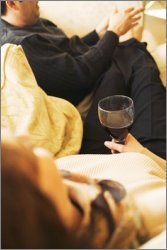26 Wine-Buying and Wine-Tasting Tips to Make
You Feel (and Sound) Like a Wine Expert
by www.SixWise.com
Do you enjoy
a good glass of wine but feel largely inadequate when
asked to choose a bottle from a restaurant menu or store shelf?
Will it go with the meal you're eating? Is it sweet or dry?
Should you let it breathe? Does it need to be chilled? And
what type of glass should you serve it in?
|

Keep in mind, enjoying a glass of wine should be a
pleasant experience, not a nerve-wracking one.
|
The endless components of wine "etiquette" and
variety truly are mind-boggling to the average wine drinker,
but there's good news.
You don't have to be a sommelier to know what you're talking
about when you talk wine. In fact, you can learn the basics
you need to impress the vast majority of your friends and
family just by reading through the tips that follow.
The Rules on Decanting
What is "decanting"? It's simply the process of
pouring wine into a glass container, or decanter, so it can
"breathe." Simply stated, being exposed to the air
begins the wine's oxidation process, which will help to improve
its flavor and aroma. Here's the scoop on decanting:
-
Red wines are typically the ones that need to breathe,
though certain white wines (particularly young, astringent
varieties like white Burgundy) may also benefit from the
process.
-
Most wines will breathe adequately in 15-20 minutes.
-
Young wines with high tannin
levels (such as a young Cabernet Sauvignon) need to "breathe"
the longest, for about an hour.
-
Mature wines (eight years old or more) should be decanted
to remove sediment from the bottle, but will lose their
peak flavor if left to sit too long.
-
Simply uncorking the wine bottle is NOT enough to let
it breathe; you must pour it into a different container,
even a wine glass or pitcher, first.
-
When you pour out the wine, pour it from as high as
you can into the container (without spilling it) so that
it gets even more air exposure as you pour.
What Temperature Should it Be?
Both red and white wines have a temperature at which their
flavors are ideal. Generally speaking, if you serve a wine
too warm it can taste alcoholic, while a wine served too cold
will lose many of its subtle flavors.
There are many intricacies to what makes a certain wine best
at a certain temperature, and this is why there are special
wine cellars and refrigerators geared at just that. But assuming
you're not going to be chilling or warming your wine to the
exact degree, here are the rules of thumb that will serve
you, and your wine, well:
-
In the United States, most people drink red wine too
warm and white wine too cold.
-
Red wine is generally best served at around 60-65 degrees
F. This is obviously much cooler than most people's "room
temperature," so you should, ideally, put your red
wine in the fridge for about 20 minutes before serving.
-
White wine, rose wines and champagne should be chilled
to about 45-50 degrees F, which is warmer than fridge
temperature (which is about 35 degrees F). For cheaper
whites, put it in the fridge about two hours before serving.
Higher quality white wines should be put in the fridge
for just about an hour before serving.
Wine Glasses: Which Type for Which Wine?
There are seemingly as many wine glasses as there are wine
varieties, but there are really only a few things you need
to know to pair a wine with a proper glass.
-
Choose a glass that's clear and plain. Etchings in the
glass and colorings detract from the complex color of
the wine.
-
Choose a glass that's large enough to hold the wine
and swirl it around to release its aroma.
-
The glass should have a stem so that you don't change
the temperature of the wine by holding it in your hand.
-
The glass should taper in at the top. This is to direct
the wine's aroma toward your nose.
-
Generally, champagne and sparkling wines should be served
in a flute, white wines in a standard (small to medium-sized)
wine glass and red wines in a glass with a larger bowl.
How to Taste Wines
|

The BEST wine is the one that you
enjoy most, no matter what the ratings or label says.
|
Wine tasting is a favorite pastime for many, and, really,
it's geared toward helping you determine which wines are your
favorites. These are the tips to fully appreciate the wines
you sample.
-
Start with the lightest wine (sparkling, rose, light
whites, heavier whites) and move to the heaviest (light
reds, heavier reds and desert wines).
-
Pour a small amount of wine in your glass and notice
the color. Younger red wines will be redder than older
ones, which tend to be more brick-colored or brown. Whites
that are older will have more color and may take on honey
hues.
-
Swirl the glass. This helps to aerate the wine and release
the aroma.
-
Sniff the wine by putting your nose in the glass. Notice
the fruity or earthy aromas.
-
Take a sip and let the wine spread over your tongue.
Swish it around your mouth gently and hold it there to
notice all the complexities of its flavor.
-
If you're only tasting a few wines, it's OK to swallow
them, but if you're at a large tasting you should spit
the wine out into the provided receptacle.
-
Take a sip of water to cleanse your palate, then repeat.
Miscellaneous, But Important, Wine Tips
Here are the final tidbits you need to round out your wine
repertoire.
-
When choosing a wine in a store, don't be swayed by
a fun label. Just because it's cute or decorated for the
season doesn't make it a good wine.
-
When choosing a wine, be wary of those up front or near
the counter in displays. These are often the slow movers
that the store is trying to unload.
-
Remember that choosing a wine is about your personal
preference. You can usually rely on notes written by wine-shop
staff to attest to the wine's flavor or sweetness, or
ask an employee to point out some wines that suit your
palette and price range. Many wine shops and supermarkets
also hold wine tastings so you can get an idea of what
you like.
-
As a general rule of thumb, pair lighter wines with
lighter foods, and heavier wines with heavy foods.
-
To save leftover wine, red or white, pour it into a
small glass container so that there is NO air left in
it (a glass jar works well for this). You may spill a
bit of the wine to do this, it will be that full. However,
the absence of air will keep the wine from oxidizing too
much. Store the container in your refrigerator, then take
it out prior to serving to allow it to warm slightly.
Recommended Reading
How
True IS the Phrase 'In Vino Veritas' ('In Wine There Is Truth')?
Procyanidin:
Why This Tannin Keeps Your Arteries Flexible and Blood Pressure
Low